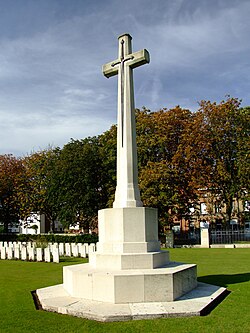Cross of Sacrifice
| Cross of Sacrifice | |
|---|---|
| Commonwealth of Nations | |

Cross of Sacrifice in Ypres Reservoir Cemetery in Belgium
|
|
| For Commonwealth military personnel who died during the First World War | |
| Unveiled | 1920 |
The Cross of Sacrifice is a Commonwealth war memorial designed in 1918 by Sir Reginald Blomfield for the Imperial War Graves Commission (now the Commonwealth War Graves Commission). It is present in Commonwealth war cemeteries containing 40 or more graves. Its shape is an elongated Latin cross with proportions more typical of the Celtic cross, with the shaft and crossarm octagonal in section. It ranges in height from 18 to 24 feet (5.5 to 7.3 m). A bronze longsword, blade down, is affixed to the front of the cross (and sometimes to the back as well). It is usually mounted on an octagonal base. It may be freestanding or incorporated into other cemetery features. The Cross of Sacrifice is widely praised, widely imitated, and the archetypal British war memorial. It is the most imitated of Commonwealth war memorials, and duplicates and imitations have been used around the world.
The First World War introduced killing on such a mass scale that few nations were prepared to cope with it. Millions of bodies were never recovered, or were recovered long after any identification could be made. Hundreds of thousands of bodies were buried on the battlefield where they lay. It was often impossible to dig trenches without unearthing remains, and artillery barrages often uncovered bodies and flung the disintegrating corpses into the air. Many bodies were buried in French municipal cemeteries, but these rapidly filled to capacity. Due to the costs and sheer number of remains involved, Australia, Canada, India, Newfoundland, New Zealand, South Africa, and the United Kingdom barred repatriation of remains.
Fabian Ware, a director of the Rio Tinto mining company, toured some battlefields in as part of a British Red Cross mission in the fall of 1914. Ware was greatly disturbed by status of British war graves, many of which were marked by deteriorating wooden crosses, haphazardly placed and with names and other identifying information written nearly illegibly in pencil. Ware petititoned the British government to establish an official agency to oversee the locating, recording, and marking of British war dead, and to acquire land for cemeteries. The Imperial War Office agreed, and created the Graves Registration Commission in March 1915. In May, the Graves Registration Commission ceased to operate an ambulance service for the British Red Cross, and in September was made an official arm of the military after being attached to the Royal Army Service Corps.
...
Wikipedia
